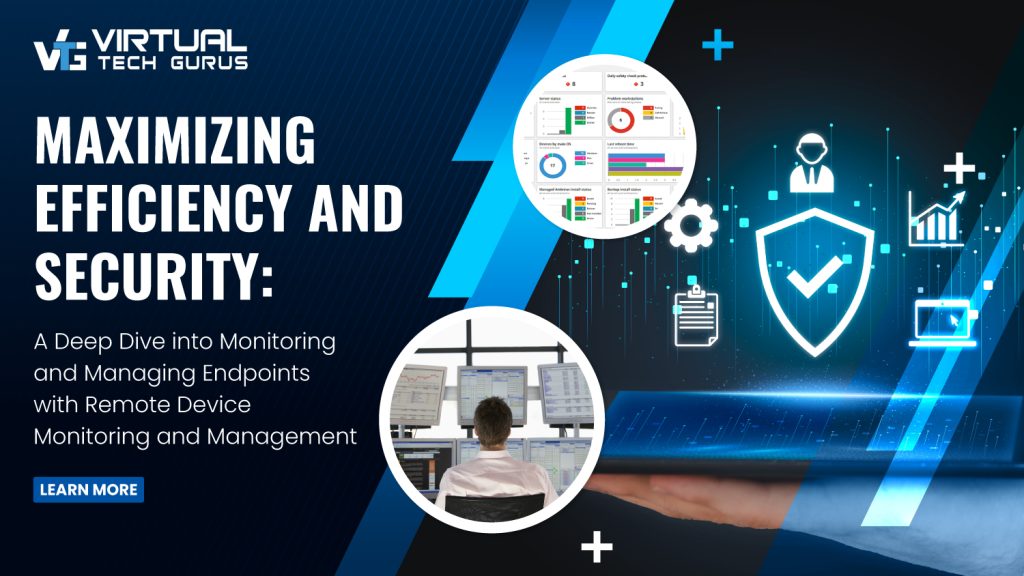
Maximizing Efficiency and Security
In the rapidly evolving landscape of IT infrastructure, the efficient monitoring and management of endpoints play a pivotal role in ensuring seamless operations and robust security. As organizations increasingly embrace remote work and diverse device ecosystems, the need for a comprehensive approach to Endpoint Management becomes more apparent. In this blog post, we will explore the significance of Monitoring and Managing Endpoints with Remote Device Monitoring and Management (RDM).
Understanding Endpoints in Modern IT:
Endpoints refer to the devices connected to a network, such as computers, laptops, mobile devices, and servers. These endpoints are the entry points for potential security threats, making their effective monitoring and management crucial for maintaining a secure and optimized IT environment.
The Role of Remote Device Monitoring and Management (RDM):
Remote Device Monitoring and Management (RDM) is a proactive approach that allows IT professionals to oversee and control endpoints from a centralized location. This involves real-time monitoring, automated maintenance tasks, and the ability to troubleshoot issues without physical access to the devices. Let's delve into the key aspects that make RDM a game-changer for modern IT management.
Real-Time Monitoring:
One of the primary benefits of RDM is the ability to monitor endpoints in real-time. This means that IT administrators can gain insights into the performance, health, and security status of each device instantly. Real-time monitoring empowers organizations to detect anomalies promptly, allowing for swift response to potential issues before they escalate.
Automated Maintenance Tasks:
RDM tools enable the automation of routine maintenance tasks, such as software updates, security patching, and system optimizations. This automation not only reduces the burden on IT teams but also ensures that all endpoints across the network remain up-to-date and secure. It's a proactive approach that enhances overall system reliability and minimizes the risk of vulnerabilities.
Remote Troubleshooting:
When issues arise on endpoints, RDM allows IT professionals to diagnose and resolve problems remotely. This eliminates the need for physical presence, saving time and resources. With remote troubleshooting capabilities, organizations can ensure that their workforce experiences minimal disruptions, even in a geographically dispersed or remote working environment.
Enhanced Security Measures:
Security is a top priority in the digital age, and RDM contributes significantly to endpoint security. RDM tools often come equipped with robust security features, including encryption, authentication, and intrusion detection. These measures help safeguard sensitive data and prevent unauthorized access to devices, mitigating the risk of cyber threats.
Benefits of Monitoring and Managing Endpoints with RDM:
Improved Efficiency:
RDM streamlines IT operations by automating routine tasks, allowing IT teams to focus on more strategic initiatives.
Real-time monitoring ensures prompt identification and resolution of issues, minimizing downtime.
Enhanced Security:
Robust security features in RDM tools protect endpoints from evolving cyber threats.
Regular security updates and patches can be deployed remotely to all endpoints, ensuring a consistent security posture.
Cost Savings:
By automating tasks and reducing the need for on-site support, organizations can achieve cost savings in both time and resources.
Remote Work Support:
RDM is especially valuable in the era of remote work, as it enables IT teams to manage and support devices irrespective of their physical location.
Scalability:
RDM solutions are scalable, catering to the growing number of endpoints in organizations of all sizes.
Best Practices for Effective Endpoint Management with RDM:
Comprehensive Device Inventory:
- Begin by creating a detailed inventory of all endpoints within the network, including specifications and configurations.
Regular Monitoring and Analysis:
- Implement continuous monitoring and analysis of endpoint performance and security metrics.
- Leverage analytics to identify trends and potential issues.
Automate Routine Tasks:
- Take full advantage of automation capabilities to handle routine maintenance tasks, ensuring consistency and efficiency.
Enforce Security Policies:
- Establish and enforce security policies consistently across all endpoints, addressing vulnerabilities promptly.
Employee Training:
- Provide training to end-users on best practices for endpoint security to mitigate risks associated with user behavior.
Explore Our Advanced Remote Device Management and Monitoring Solutions
In the ever-evolving digital landscape, Virtual Tech Gurus understands the vital role of remote device management and monitoring. Our unwavering commitment to delivering high-quality solutions guarantees the security, optimization, and compliance of your devices.
Our comprehensive services include:
End-to-End Device Management: From inventory tracking to configuration, software updates, and security patching, we cover the full spectrum of device management solutions.
State-of-the-Art Security: Rely on our robust security protocols, featuring encryption and multi-factor authentication, to protect your devices and data from emerging threats.
Prompt Remote Troubleshooting: Trust us for quick and efficient remote troubleshooting and support, minimizing disruptions to your day-to-day operations.
Continuous Real-time Monitoring: Benefit from our continuous device monitoring, complemented by detailed reporting and analytics, to uphold peak performance and security.
Policy Enforcement: Ensure consistent adherence to security and compliance policies through our remote device management services.
Virtual Tech Gurus is your dependable ally in establishing and sustaining a resilient and effective IT infrastructure. Connect with us today to discover how our remote device management and monitoring services can enhance your organization. Entrust your digital future to us - your devices are in safe hands.
Conclusion:
Monitoring and Managing Endpoints with Remote Device Monitoring and Management is a strategic imperative for organizations looking to optimize efficiency and bolster security. As technology continues to advance, the role of RDM becomes increasingly critical in maintaining a resilient IT infrastructure. By embracing RDM best practices and leveraging its capabilities, organizations can stay ahead of the curve, ensuring that their endpoints remain secure, efficient, and adaptable to the demands of the digital age.
Uncover tranquillity by partnering with Virtual Tech Gurus to safeguard your business from unforeseen security breaches. Explore our cutting-edge Remote Device Management and Monitoring Solutions. Reach out today to discover how our team enhances efficiency and security through our powerful solutions.
